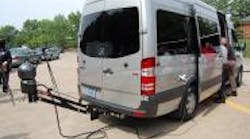Heat is a tell-tale sign of bad things happening when it comes to trucks – particularly in the case of tires, exhaust systems, and brakes. (The term “smoking the brakes” didn’t get created by happenstance, after all.)
For those reasons, many motor carrier enforcement agencies are now using infrared inspection systems or “IRIS” for short to help them quickly identify trucks with under-inflated, flat, or over-inflated tires, leaky exhaust systems, and most importantly overheated brakes.
The biggest advantage of such technology is that it can quickly identify trucks with problems in all of these areas – usually in seconds – thereby helping law enforcement officers quickly determine who’s operating good, safe equipment ... and who isn’t.
During Roadcheck 2011, the annual 72-hour safety inspection “blitz” conducted across North America under the auspices of the Commercial Vehicle Safety Alliance (CVSA), I got a chance to take a closer look at a mobile IRIS vehicle operated by the Virginia State Police – one of four such trucks in its fleet.
This one, piloted by IRIS Technician Dorothy “Dottie” Ritenour, sports the latest version of this technology, including a digital video recorder (DVR) system, which has replaced the videocassettes used with earlier models.
[Ritenour gave me an overview of how IRIS technology works, which you can view below.]
Eventually, Ritenour said the Virginia State Police would like to install “fixed” IRIS platforms at weigh stations or other locations along heavily-traveled freight corridors such as I-95 and I-81.
Yet this technology is still pricey – in the six figures, from what I can gather – so for now the 62 state troopers and supervisors dedicated to motor carrier enforcement in Virginia rely on four mobile IRIS trucks like the one Ritenour operates.
“When we use this technology, we’re setting up at the bottom of a long descent or similar down slope, one where a truck will have used its brakes frequently, so we can ‘see’ what’s happening,” she told me.
Usually, Ritenour (at left) said she gets about 10 seconds to view a truck rolling over the scales with IRIS, but that’s all she needs to make a quick determination as to whether its brakes, exhaust system, and tires are in good shape or not.
Perhaps the best thing about this technology is that it allows inspectors to focus on the folks running poorly maintained equipment, while leaving the “good apples” (so to speak) alone to continue on about their business.
The upshot is, if your equipment is in good shape, with tires properly inflated, IRIS will give you a green light and help speed you off to your destination all that much quicker. That’s a pretty positive payoff for truckers when it comes to using infrared technology, I would think.



